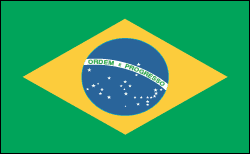
Geography
Brazil covers nearly half of South America and is the continent's largest nation. It extends 2,965 mi (4,772 km) north-south, 2,691 mi (4,331 km) east-west, and borders every nation on the continent except Chile and Ecuador. Brazil may be divided into the Brazilian Highlands, or plateau, in the south and the Amazon River Basin in the north. Over a third of Brazil is drained by the Amazon and its more than 200 tributaries. The Amazon is navigable for ocean steamers to Iquitos, Peru, 2,300 mi (3,700 km) upstream. Southern Brazil is drained by the Plata system—the Paraguay, Uruguay, and Paraná rivers.
Government
Federal republic.
History
Brazil is the only Latin American nation that derives its language and culture from Portugal. The native inhabitants mostly consisted of the nomadic Tupí-Guaraní Indians. Adm. Pedro Alvares Cabral claimed the territory for Portugal in 1500. The early explorers brought back a wood that produced a red dye, pau-brasil, from which the land received its name. Portugal began colonization in 1532 and made the area a royal colony in 1549.
During the Napoleonic Wars, King João VI, fearing the advancing French armies, fled Portugal in 1808 and set up his court in Rio de Janeiro. João was drawn home in 1820 by a revolution, leaving his son as regent. When Portugal tried to reimpose colonial rule, the prince declared Brazil's independence on Sept. 7, 1822, becoming Pedro I, emperor of Brazil. Harassed by his parliament, Pedro I abdicated in 1831 in favor of his five-year-old son, who became emperor in 1840 (Pedro II). The son was a popular monarch, but discontent built up, and in 1889, following a military revolt, he abdicated. Although a republic was proclaimed, Brazil was ruled by military dictatorships until a revolt permitted a gradual return to stability under civilian presidents.
President Wenceslau Braz cooperated with the Allies and declared war on Germany during World War I. In World War II, Brazil again cooperated with the Allies, welcoming Allied air bases, patrolling the South Atlantic, and joining the invasion of Italy after declaring war on the Axis powers.
After a military coup in 1964, Brazil had a series of military governments. Gen. João Baptista de Oliveira Figueiredo became president in 1979 and pledged a return to democracy in 1985. The election of Tancredo Neves on Jan. 15, 1985, the first civilian president since 1964, brought a nationwide wave of optimism, but when Neves died several months later, Vice President José Sarney became president. Collor de Mello won the election of late 1989, pledging to lower hyperinflation with free-market economics. When Collor faced impeachment by Congress because of a corruption scandal in Dec. 1992 and resigned, Vice President Itamar Franco assumed the presidency.
A former finance minister, Fernando Cardoso, won the presidency in the Oct. 1994 election with 54% of the vote. Cardoso sold off inefficient government-owned monopolies in the telecommunications, electrical power, port, mining, railway, and banking industries.
In Jan. 1999, the Asian economic crisis spread to Brazil. Rather than prop up the currency through financial markets, Brazil opted to let the currency float, which sent the real plummeting—at one time as much as 40%. Cardoso was highly praised by the international community for quickly turning around his country's economic crisis. Despite his efforts, however, the economy continued to slow throughout 2001, and the country also faced an energy crisis. The IMF offered Brazil an additional aid package in Aug. 2001. And in Aug. 2002, to ensure that Brazil would not be dragged down by neighboring Argentina's catastrophic economic problems, the IMF agreed to lend Brazil a phenomenal $30 billion over fifteen months.
In Jan. 2003, Luiz Inácio Lula da Silva, a former trade union leader and factory worker widely known by the name Lula, became Brazil's first working-class president. As leader of Brazil's only Socialist party, the Workers' Party, Lula pledged to increase social services and improve the lot of the poor. But he also recognized that a distinctly nonsocialist program of fiscal austerity was needed to rescue the economy. The president's first major legislative success was a plan to reform the country's debt-ridden pension system, which operated under an annual $20 billion deficit. Civil servants staged massive strikes opposing this and other reforms. Although public debt and inflation remained a problem in 2004, Brazil's economy showed signs of growth and unemployment was down. Polls in Aug. 2004 demonstrated that the majority of Brazilians supported Lula's tough economic reform efforts. He combined his conservative fiscal policies with ambitious antipoverty programs, raising the country's minimum wage by 25% and introducing an ambitious social welfare program, Bolsa Familia, which has pulled 36 million people (20% of the population) out of deep poverty.
In 2005, an unfolding bribery scandal weakened Lula's administration and led to the resignation of several high government officials. Lula issued a televised apology in August, promising “drastic measures” to reform the political system. By the following year, his popularity had rebounded as he continued a successful balancing act between fiscal responsibility and a strong social welfare system. But after another corruption scandal surfaced right before the Oct. 2006 election, Lula won only 48.6% of the vote, forcing a runoff election on Oct. 29 in which Lula garnered 60.8% of the vote, retaining his office.
Brazil suffered its worst aviation accident in its history in July 2007, when an Airbus 320 skidded off a runway in São Paulo and crashed into an office building, killing 176 people. The accident sparked a crisis in Brazil and led to the cancellation or delay of hundreds of flights and the firing of the defense minister, who oversaw civil aviation.
Hiç yorum yok:
Yorum Gönder